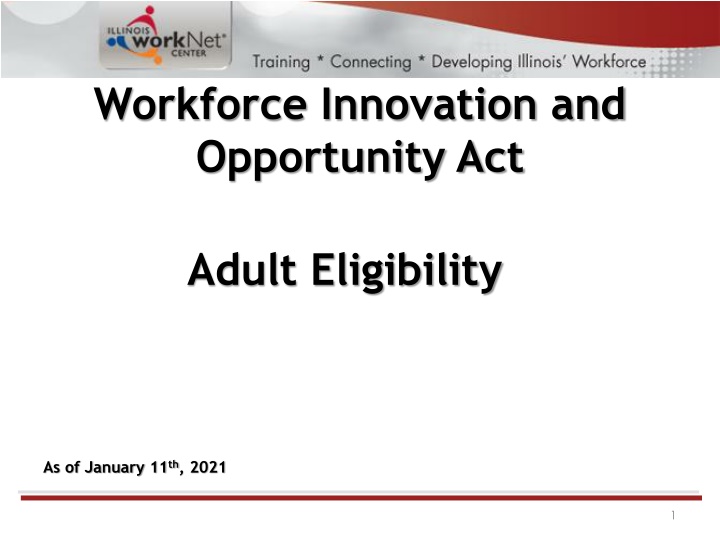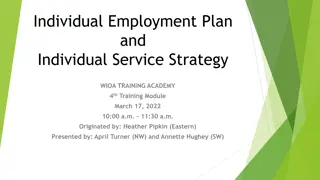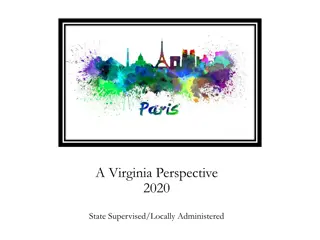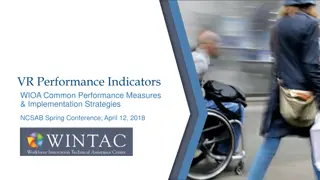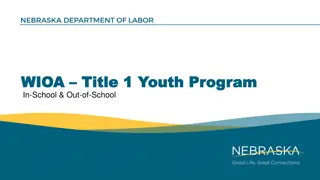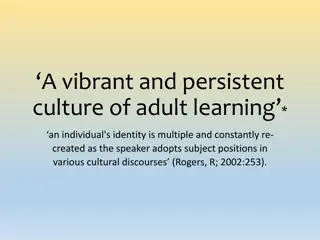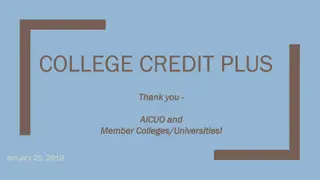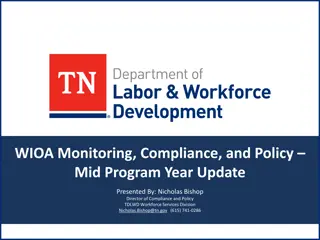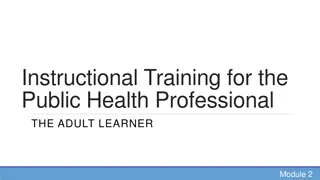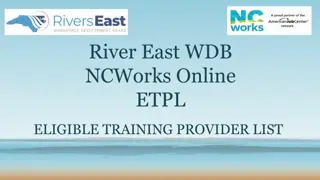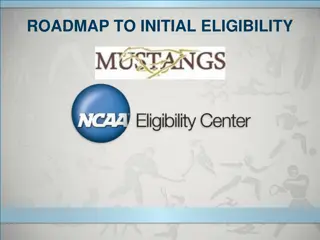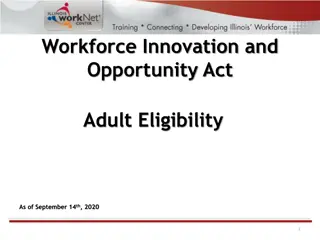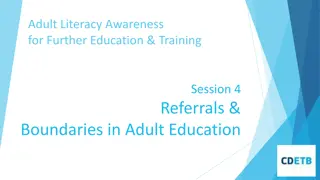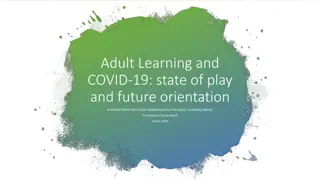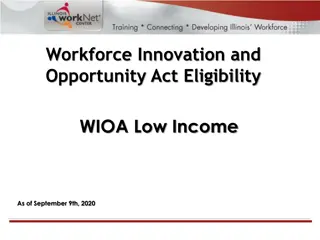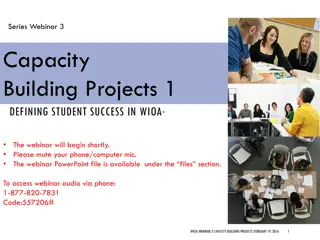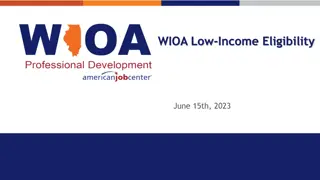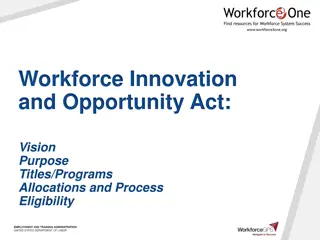WIOA Adult Eligibility Guidelines
The Workforce Innovation and Opportunity Act (WIOA) establishes eligibility criteria for adults seeking workforce services. Individuals must meet age, citizenship, and selective service registration requirements to qualify for assistance. Changes from the Workforce Investment Act (WIA) include a shift in service delivery and coordination with partner agencies.
Download Presentation

Please find below an Image/Link to download the presentation.
The content on the website is provided AS IS for your information and personal use only. It may not be sold, licensed, or shared on other websites without obtaining consent from the author.If you encounter any issues during the download, it is possible that the publisher has removed the file from their server.
You are allowed to download the files provided on this website for personal or commercial use, subject to the condition that they are used lawfully. All files are the property of their respective owners.
The content on the website is provided AS IS for your information and personal use only. It may not be sold, licensed, or shared on other websites without obtaining consent from the author.
E N D
Presentation Transcript
Workforce Innovation and Opportunity Act Adult Eligibility As of January 11th, 2021 1
WIOA Title 1 Authorization Workforce Innovation and Opportunity Act of 2014 2
Understanding the ePolicy Manual The Illinois Department of Commerce and Economic Opportunity, Office of Employment and Training (OET) utilizes a WIOA ePolicy portal where all current and new guidance issued by the Illinois Workforce Innovation Board (IWIB) and OET will be maintained. Homepage: www.illinoisworknet.com/DCEOPolicies 3
WIOA Title 1 Authority Workforce Innovation and Opportunity Act of 2014 Training and Employment Guidance Letter (TEGL) 19-16 Guidance on Services Provided through Adult and Dislocated Worker under WIOA dated March 1st, 2017 TEGL 7-20 Implementation of Priority of Service in WIOA Adults dated November 24th, 2020 WIOA ePolicy Chapter 5 - General Eligibility WIOA ePolicy Chapter 5.1.1 1.1.4 Selective Service WIOA ePolicy Chapter 5.2 Adult Eligibility WIOA ePolicy Chapter 5.5 - Low-Income Individuals WIOA ePolicy Chapter 5.6 Service Priorities Commerce Notice NO. 19-NOT-01, Change 3 Basic Skills Deficiency dated December 9th, 2020 4
General Eligibility and Low Income Prior to reviewing this presentation on Adult Eligibility, it is important that you view and understand the details that were covered in the presentation on: WIOA General Eligibility 1-7-2021 WIOA Low Income 1-7-2021 WIOA Basic Skills Deficient 1-11-2021 5
WIOA Adult Eligibility WIOA ePolicy Chapter 5.2 Adult Eligibility WIOA Legislation requires that an Adult be 18 years of age or older Be a citizen or noncitizen authorized to work in the US; and Meet Military Selective Service registration requirements (males only) 6
Changes from WIA to WIOA Adult There is no longer a sequence of services; a participant may receive services in any order that is deemed appropriate. Core and Intensive WIA services were combined into Career Services under WIOA. Coordination with outside agencies (WIOA partners) is permitted to provide comprehensive services to participants. 7
WIOA Adult Priority WIOA Adult clients who meet WIOA Low Income criteria are a priority under WIOA Legislation. WIOA Adult clients who are determined Basic Skills Deficient (BSD) or are considered English Language Learners (ELL) are a priority under WIOA Legislation. It is important to understand, Low Income, BSD & ELL are equal priorities under the Adult title. 8
Veterans Priority of Service As was addressed in the WIOA General Eligibility presentation, based on guidance in the Jobs for Veterans Act, a Veteran or Qualified Spouse of a Veteran must receive priority of service over other qualified individuals who are not a Veteran or Qualified Spouse of a Veteran. 9
Adult Priority Per WIOA ePolicy 5.6 Service Priorities 1. Veterans and eligible spouses who meet WIOA low- income criteria or are BSD or ELL. 2. Individuals who are not veterans, who meet WIOA low-income criteria, or are BSD or ELL. 3. Veterans or eligible spouses who do not meet WIOA low-income criteria and are not BSD or ELL. 4. Non-veterans who do not meet WIOA low-income criteria or BSD/ELL criteria. 10
DOL TEGL 7-20 Department of Labor issued TEGL 7-20, Implementation of Priority of Service in WIOA Adults in November 2020: This new guidance is issuing a threshold for each state (which in turn will be monitored down to each LWIA,) to serve at least 75% of their Adult population in one or more of the priority groups of Low Income, Basic Skills Deficient (including English Language Learners), as well as Veterans or Qualified Spouse of a Veteran. In December 2020, our programmers ran various ad hoc reports by LWIA, and by and large every LWIA has exceeded 75% of their Adult Registrants in PY19 and (from 7-1-20 to date) in PY20. 11
DOL TEGL 7-20 Tracked by Exiters Department of Labor issued TEGL 7-20, Implementation of Priority of Service in WIOA Adults in November 2020: Closer examination of TEGL 7-20, it was noted that DOL will be tracking this Adult Priority based on Adult Exiters in PY20 (7-1-20 6-30-21) to capture a baseline on how each state (and each LWIA) has been doing regarding serving Adult clients who have met the WIOA Adult Priorities outlined in the WIOA legislation. Basically, for those working with the Adult title, keep doing what you have been regarding following the Adult priorities and everything will work well. 12
Reports for Tracking Adult Priorities A new report under the Reporting Menu (Participant Reports), called Non-Priority 1A Adult Report: This report will allow each LWIA the ability to run a report, for a given period that identifies the clients who are currently being served under the Adult Funding stream that had not met any of the WIOA Adult priorities. See the next slide for a screen print of the actual report criteria screen. 13
Example Results from a Non-Priority 1A Adult Report From the Training Platform of IWDS, below is an example of results from the report: 15
Another New Report on the Way There is another new report currently in development that will be added to the reporting menu soon. It will be run by LWIA, program year and either by Registrant or Exiter, showing how the LWIA has done or is doing serving Adult clients who meet one or more of the Adult Priorities. This report will also provide a detailed numeric breakdown on how the Adult clients have met the different Adult Priorities during the selected reporting period. 16
WIOA Adult Low Income As was addressed in the WIOA Low Income presentation, below are the six different ways an Adult client could meet WIOA Low Income criteria: 1. Cash Welfare 2. Food Stamps 3. Homeless 4. Foster Child 5. Family Income Calculation 6. Family of One Due to a Disability (Requires the client to have a disability, and their own income be below the low-income threshold for a family size of one.) 17
WIOA Adult Low Income If a qualified Adult client meets any one or more of the six WIOA Low Income criteria shown on the previous slide, they should be certified under Adult Low Income and receive priority under the WIOA Adult title. 18
Basic Skills Deficient Basic Skills Deficient respect to an individual (A) who is a youth, that the individual has English reading, writing, or computing skills at or below the 8th grade level on a generally accepted standardized test; or (B) who is a youth or adult, that the individual is unable to compute or solve problems, or read, write, or speak English, at a level necessary to function on the job, in the individual s family, or in society. 19
Basic Skills Deficient As was covered in the standalone presentation on Basic Skills Deficient (BSD), there are three different ways an Adult client could meet the WIOA Adult Priority tied to BSD: 1. Scoring at or below 8th Grade Level Equivalency (GLE) on their pre-assessment math or reading tests. 2. Being determined BSD due to the Basic Skills Screening Tool. 3. If an Adult Client is assessed as an English Language Learner (ELL). 20
Basic Skills Screening Tool Ifan individual replies No to any of the following questions on the screening tool, they can be determined BSD: 21
Basic Skills Screening Tool Within IWDS, on the Education Status screen within the application, is where the question has been added when a client is being determined BSD due to the new screening tool. If any question on the screening tool is answered No by the client, then the question related to the BSD screening tool on the Education Status screen should be answered Yes ; (see example on next slide). 22
Basic Skills Screening Tool Demonstrating recording BSD due to the screening tool. 23
English Language Learner English Language Learner when used with respect to an eligible individual, means an eligible individual who has limited ability in reading, writing, speaking, or comprehending the English language, and (A) whose native language is a language other than English; or (B) who lives in a family or community environment where a language other than English is the dominant language. 24
English Language Learner Within IWDS, on the Characteristics and Barriers screen within the application, is where the question has been added when a client is being determined an English Language Learner (ELL). If the question is populated with a Yes , the client must pass on a Language of Preference; (see example on next slide). 25
English Language Learner (ELL) Demonstrating barrier of ELL being recorded. 26
Basic Skills Deficient (BSD) A key internal logic item in IWDS to understand about BSD from assessment tests: The assessment test date must be, on or before the application date before the internal logic within IWDS is going to pick up the client as BSD due to the assessment test: Example, if a client has an application date of 1/4/2021, but was given the assessment test(s) on a date after 1/4/2021, even if the client scores at or below 8th Grade Level on the assessment test(s), the internal IWDS logic would not determine the individual BSD based on the assessment test. 27
Adult Training Services Prior to certification under Training Services an Adult client must have: Documented Assessment Individual Employment Plan (IEP) 28
Individual Employment Plan (IEP) IEP - A plan developed by the participant and the career planner to identify the participant's employment goal, the appropriate achievement objectives, and the appropriate combination of services for the participant to achieve the employment goal, including providing information on eligible providers of training services and career pathways to attain career objectives. 29
Adult Training Services The Assessment and IEP could be completed by either the LWIA staff (Career Planner); WIOA Core partner staff (Adult Ed., Wagner Peyser, Vocational Rehab, TANF staff); Training Provider or staff from some other agency. Most often the assessment and IEP will be completed by the WIOA Adult Career Planner at the LWIA. 30
Co-Enrolled Adult WIOA Adult clients who meet the priority of services Low Income and/or Basic Skills Deficient can be co-enrolled with an age- appropriate Youth title or a Dislocated Worker title to break up funding of services: If this is done, the client cannot exit from one title until services from all titles are completed. If this is done, the client would fall into performance outcomes for each title that the client is registered. 31
WIOA Adult Eligibility To recap, for overall WIOA Adult Eligibility a client must be 18 years of age or older, be legally authorized to work in the U.S. and if born a male, who was born on or after 1/1/1960, must be compliant with Selective Service requirements. 32
Adult Eligibility and Priorities However, it is important that the priorities laid out in the OET WIOA Priorities Policy is followed, meaning: Veterans Priority of Service must be followed. Any qualified Adult who meets WIOA Low Income criteria (please see separate power point on WIOA Low Income) or is Basic Skills Deficient or is considered an English Language Learner (please see separate power point on BSD) must be served priority to eligible Adults who do not meet the priorities laid out. 33
WIOA Adult Eligibility This concludes the presentation on WIOA Adult Eligibility. If you have any questions, feel free to contact me at james.potts@Illinois.gov or you can call me at (217) 416-7097. 34
